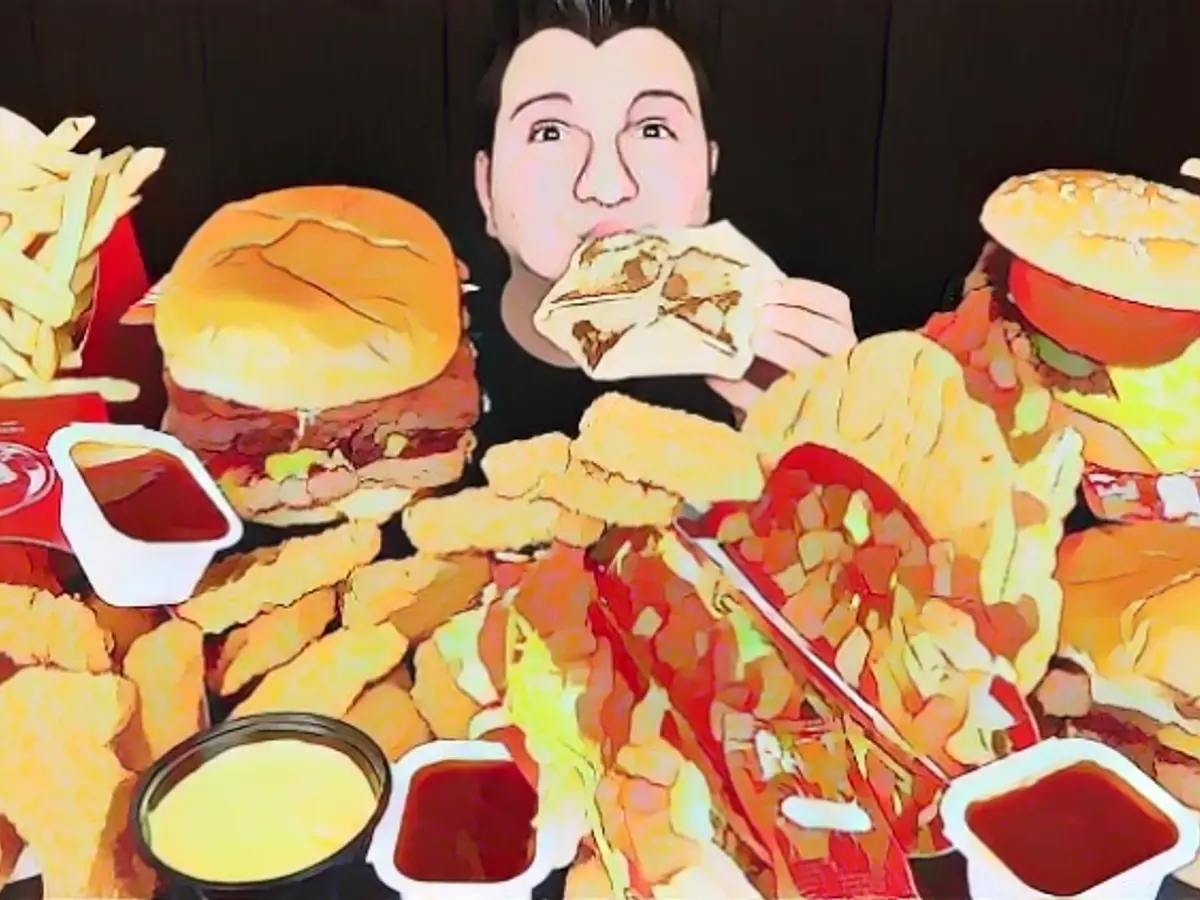"Countertrend to the acceleration of everyday life"
Under the title "ASMR Mok-Bang", food videos are becoming a hit on the internet. People devour huge mountains of burgers, pasta or cakes seemingly effortlessly - and munch loudly into the microphone. In an interview with ntv.de,Claus-Christian Carbon,psychologist and professor at the Otto-Friedrich University of Bamberg, explains what is behind this strange trend .
ntv.de: Watching other people eat sounds pretty unspectacular. But on YouTube, videos under the title "ASMR Mok-Bang" generate millions of clicks. What captivates viewers?
Professor Carbon: Mok-Bang or Muk-Bang - this trend from South Korea has already become a real movement. What's fascinating about the videos is that what normally runs in the background suddenly becomes the focus. This changes our perception and we can suddenly see details that we would otherwise simply filter out. We are also familiar with this new perceptual condition from art and culture, where we are often spellbound.
ASMR stands for "Autonomous Sensory Meridian Response". What positive effects are hidden behind this phenomenon?

The term was coined by the community itself and is therefore not initially a uniform, scientifically researched phenomenon. The content in this large ASMR container is correspondingly heterogeneous. However, almost all of these videos have the following characteristics in common: a strong aestheticization, i.e. the videos are aesthetically staged. This also gives them a peculiar atmosphere that appears quite unnatural. This artificiality is supported by a peculiar speaking and recording technique of the voice. It is usually positioned unusually close, almost intimately close, to the microphone. Typical hissing, whispering or whispering noises are not filtered out, but on the contrary amplified, pronounced or explicitly triggered.
What else distinguishes the videos from others?
They contain hardly any action and provide no information. What's more, they are very long, sometimes over two hours. All of this is in contrast to videos that are usually consumed on YouTube, such as tutorials, explanatory videos or information programs. In short: a real counter-trend to fast, dense and information-rich videos! And therefore also a counter-trend to the constant acceleration of everyday life.
So far, there have been relatively few studies on the subject of ASMR. What has science already found out?
As far as I know, we are the only research unit in the German-speaking world at my chair at the University of Bamberg that is systematically studying ASMR. We are primarily interested in the phenomenology of ASMR, i.e. how ASMR affects us. And here we have made some exciting discoveries: For one thing, we don't differentiate between ASMR-lers and non-ASMR-lers. Rather, we become ASMR learners once we have really engaged with it intensively. Secondly, ASMR only takes effect after some time of observation and above all because you have to cope with sometimes unfamiliar and aversive stimuli. However, once you have become accustomed to these stimuli through so-called habituation, you slowly reach a state of relaxation, which is only broken by a new sequence in the video. After that, however, we fall further and further into relaxation, which often leads to falling asleep after more than an hour.
So is there an ASMR-er in all of us?
Initially, the test subjects were very different: Some loved it, others categorically rejected it. However, if the latter group simply "stuck with it" and continued watching, they also began to benefit from ASMR: A calming and relaxing effect then set in for them too.
Is there also a voyeuristic component?
Any type of video can have a voyeuristic component, as it is an asymmetrical medium. When it comes to food in particular, we would never typically focus so much on the eating behavior of the person we are watching in everyday life, as this would be socially unacceptable. ASMR videos, on the other hand, allow us to live this out and usually make us really want to eat and enjoy ourselves.
Cheese, chocolate, burgers: the South Korean food trend often involves eating unhealthy foods in gigantic quantities. What triggers this?
It's mainly large quantities, but not always just unhealthy things that are consumed here. That alone is somewhat characteristic and of course also creates exciting initial situations, because the people here are completely full. At the same time, the protagonists usually appear slim and slender. This offers a hedonic appeal.
Are there any health risks behind the eating trend?
Eating attentively and watching people eat should not initially be seen as dangerous. In addition, the videos tend to be designed in such a way that a lot is eaten, but not necessarily devoured. This distinguishes the trend from typical binge-eating behavior. However, it cannot be ruled out that certain groups of people may be motivated to eat a disproportionate amount. In fact, this is not the aim of the videos, which are more about mindfulness and sensuality.
What fascinates you personally about ASMR?
I approach the topic with research glasses. I am primarily interested in understanding what millions of people actively seek out, even though it seems impossible at first glance. It is important to understand psychological phenomena and trends in depth and not leave it to half-knowledge.
Do you remember the most absurd ASMR video you have ever seen?
During my research, I am confronted with a lot of absurd content: Eating a kebab for an hour is certainly extreme, even if you consider that it probably gets pretty cold, that kebab. Or watching someone shovel huge amounts of scampi into themselves. Today, I look at the whole thing through analytical glasses and am more interested in the reasons why people can be so enthusiastic about this content.
Leah Nowak spoke with Prof. Dr. Claus-Christian Carbon
Read also:
- This will change in December
- Attacks on ships in the Red Sea: shipping companies avoid important trade route
- Houthi rebels want to launch further attacks despite international coalition
- USA forms military coalition against Houthi attacks on ships in the Red Sea
The trend of ASMR Mok-Bang, originating from South Korea, has gained popularity on YouTube, with people watching and listening to others consume large amounts of food. This trend is considered a countertrend to the fast-paced everyday life, as it provides a slow, mindful experience.
Professor Carbon, a psychologist from Germany, suggests that the fascination with ASMR Mok-Bang videos could be due to the shift in focus from the background to the foreground, allowing viewers to perceive details they would otherwise miss. He also highlights the role of ASMR, a phenomenon associated with relaxation and reduction of stress, in these videos.
Furthermore, the videos often involve the consumption of food, such as burgers, pasta, and cakes, which could be linked to the nutritional aspect of health. The slow pace and long duration of the videos contrast with typical fast-paced YouTube content, providing a different experience and offering a countertrend to the constantly accelerating everyday life.
Source: www.ntv.de







